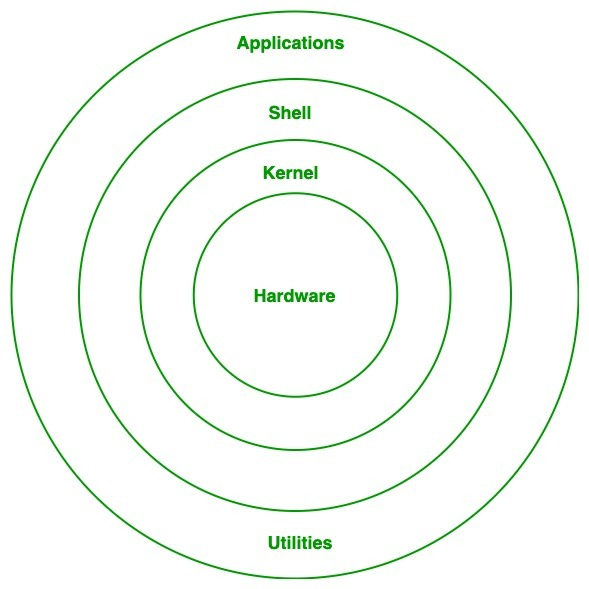Linux Operating System
一、What is Linux Operating System
The Linux Operating System is a type of operating system that is similar to Unix, and it is built upon the Linux Kernel. The Linux Kernel is like the brain(大脑) of the operating system because it manages how the computer interacts with its hardware and resources. It makes sure everything works smoothly and efficiently. But the Linux Kernel alone is not enough to make a complete operating system. To create a full and functional system, the Linux Kernel is combined with a collection of software packages and utilities, which are together called Linux distributions. These distributions make the Linux Operating System ready for users to run their applications and perform tasks on their computers securely and effectively. Linux distributions come in different flavors(特色), each tailored(专门的) to suit the specific needs and preferences of users.
Linux是一个类似Unix的开源操作系统,基于Kernel开发。Kernel是Linux的大脑,他管理计算机硬件和软件的交互。他确保所有的操作顺利有效的运行。但是单凭一个Kernel不能制作一个操作系统。创建一个全面有效的操作系统,Kernel需要联合软件包和实用程序,这些软件包和实用统称为Linux发行版。这些发行的Linux版本为用户在他们的计算机上安全有效的运行应用和执行任务做好准备。
What is Linux
Linux is a powerful and flexible family of operating systems that are free to use and share. It was created by a person named Linus Torvalds in 1991. What’s cool is that anyone can see how the system works because its source code is open for everyone to explore and modify. This openness encourages people from all over the world to work together and make Linux better and better. Since its beginning, Linux has grown into a stable and safe system used in many different things, like computers, smartphones, and big supercomputers. It’s known for being efficient, meaning it can do a lot of tasks quickly, and it’s also cost-effective, which means it doesn’t cost a lot to use. Lots of people love Linux, and they’re part of a big community where they share ideas and help each other out. As technology keeps moving forward, Linux will keep evolving and staying important in the world of computers.
Linux是一个强大而灵活的操作系统家族,而且可以免费使用和分享。他是由一个叫Linux Torvalds的人在1991年发明的。更酷的似乎每个人可以看到系统是如何工作的,因为他的代码是开源的,每个人可以探索和修改。这种开源性鼓励全世界的人们一个努力让LInux变得越来越好。自诞生以来,Linux就发展成为一个稳定并且安全的系统,应用在不同领域,比如计算机,手机和超级计算机。它以高效著称,这意味着它可以快速处理很多任务;它以成本效益著称,这意味着它不会花费用户很多。很多人喜欢Linux,他们是社区的一部分,在社区里边他们分享方法,互相帮忙。技术不断发展,Liunx将不断发展,并在计算机世界保持重要的地位。
Linux Distribution
Linux distribution is an operating system that is made up of a collection of software based on Linux kernel or you can say distribution contains the Linux kernel and supporting libraries and software. And you can get Linux based operating system by downloading one of the Linux distributions and these distributions are available for different types of devices like embedded devices, personal computers, etc. Around 600 + Linux Distributions are available and some of the popular Linux distributions are:
- MX Linux
- Manjaro
- Linux Mint
- elementary
- Ubuntu
- Debian
- Solus
- Fedora
- openSUSE
- Deepin
Linux发行版
Linux发行版是一个开源的操作系统,它有基于内核的软件组成,或者说发行版包括Linux内核及支持的库和软件。你可以下载任意一个Linux发行版,来获取基于Linux的操作系统,这些发行版适用于不同类型的设备,像移动手机,个人电脑以及其他。大概有600多个Linux发行版可用,比较流行的发行版有如下:
Architecture of Linux
Linux结构
Linux architecture has the following components:

- Kernel: Kernel is the core of the Linux based operating system. It virtualizes the common hardware resources of the computer to provide each process with its virtual resources. This makes the process seem as if it is the sole process running on the machine. The kernel is also responsible for preventing and mitigating conflicts between different processes. Different types of the kernel are:
- Monolithic Kernel
- Hybrid kernels
- Exo kernels
- Micro kernels
Kernel是基于linux为基础的系统的核心;它虚拟化计算机共有硬件资源,给每个进程提供虚拟资源;这就导致每个进程在设备上都是独立运行的进程。Kernel同时还组织并减缓进程间的冲突。不同类型的Kernel分为:
单片内核;
混合内核;
Exo内核;
围观内核;
- System Library:Linux uses system libraries, also known as shared libraries, to implement various functionalities of the operating system. These libraries contain pre-written code that applications can use to perform specific tasks. By using these libraries, developers can save time and effort, as they don’t need to write the same code repeatedly. System libraries act as an interface between applications and the kernel, providing a standardized and efficient way for applications to interact with the underlying system.
系统库:
Linux用户系统库,也可以称为共享库,来实现各种系统函数。这个库包含了预处理代码,应用程序可以使用它来执行特殊的任务。通过使用系统库,开发者可以节省时间和精力,因为他们不用重复的写相同的代码。系统库扮演了应用和内核之间接口的角色,它给因公和底层系统提供了标准化高效的交互方式。
- Shell:The shell is the user interface of the Linux Operating System. It allows users to interact with the system by entering commands, which the shell interprets and executes. The shell serves as a bridge between the user and the kernel, forwarding the user’s requests to the kernel for processing. It provides a convenient way for users to perform various tasks, such as running programs, managing files, and configuring the system.
Shell:Shell是Linux操作系统的用户界面。它可以让用户通过命令来与系统交互,shell解释和执行这些命令。Shell充当用户和内核之间的桥梁,转发用户的需求给内核处理。他给用户提供处理很多任务的方便方式,例如运行程序,管理文件,配置系统。
- Hardware Layer: The hardware layer encompasses all the physical components of the computer, such as RAM (Random Access Memory), HDD (Hard Disk Drive), CPU (Central Processing Unit), and input/output devices. This layer is responsible for interacting with the Linux Operating System and providing the necessary resources for the system and applications to function properly. The Linux kernel and system libraries enable communication and control over these hardware components, ensuring that they work harmoniously together.
硬件层:硬件层包含服务器的所有硬件组件,比如RAM,HDD,CPU,输入输出设备。这一层负责与Linux操作系统交互,并提供系统和应用程序正常运行所需的资源。Linux 内核和系统库可以与硬件交流并且控制硬件的所有组件,确保他们能和谐的协同工作。
- System Utility: System utilities are essential tools and programs provided by the Linux Operating System to manage and configure various aspects of the system. These utilities perform tasks such as installing software, configuring network settings, monitoring system performance, managing users and permissions, and much more. System utilities simplify system administration tasks, making it easier for users to maintain their Linux systems efficiently.
系统应用程序:系统应用程序是Linux提供的基本工具和程序,用来管理和配置系统各方面。这些程序执行如下任务,比如安装软件,配置网络,监控系统进程,管理用户及权限等等。系统应用程序简化了系统管理,让用户可以更加简单有效的管理Linux操作系统。



